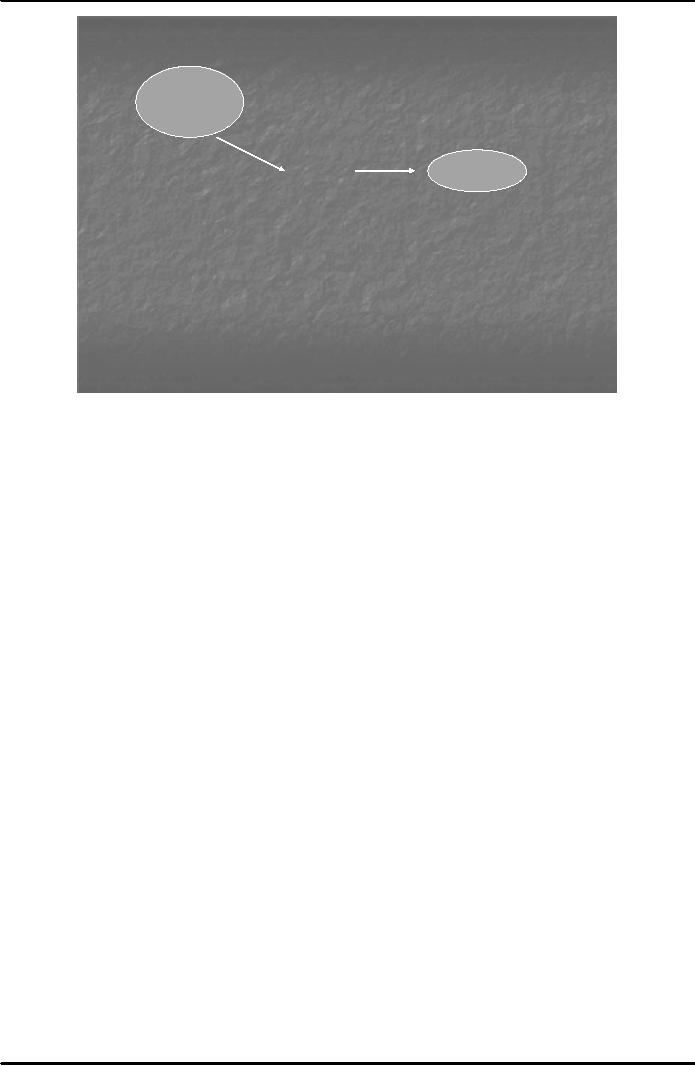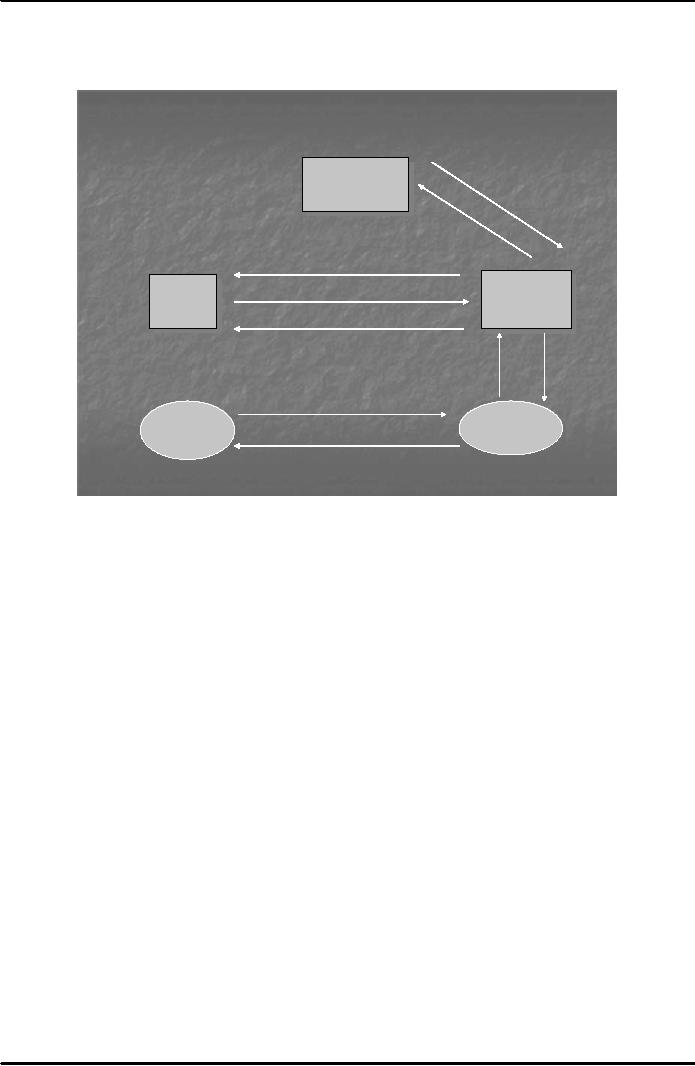 |
E-CASH PAYMENT SYSTEM 2 |
| << E-CASH PAYMENT SYSTEM 1 |
| SECURE SOCKET LAYER (SSL) >> |

E-COMMERCE
IT430
VU
Lesson
27
E-CASH
PAYMENT SYSTEM
How
anonymity is ensured in e-cash
payment system?
Anonymity
in e-cash system means that
the identity of the client/buyer is not
disclosed. Note that there
are
two
main stages in this payment
mechanism minting stage
and deposit stage. At minting
stage the serial
no. is
signed by the e-cash bank to provide
third part of a valid e-cash
coin. At this stage the bank knows
as
to who
amongst its different
account holders or clients is
requesting for the bank's
signatures on the serial
no.,
but it does not know the
serial no. it is signing due
to the blinding factor "r". On the
other hand, the
reverse
is true at the deposit stage (when the
coins are sent to e-cash
bank for checking validity).
Now, bank
knows
the serial no. (it had
earlier signed blindly at the
minting stage) but has no
clue about the specific
client
who has sent them for
payment purposes. The bank
may have issued coins to
many of its clients.
It
would
not be known to the bank at the deposit
stage that who amongst them
has done the shopping and is
making the
payment now. Thus, by
scheme, the relationship between the
client and the serial no. is
broken
at the
minting and deposit stage to
ensure anonymity of the client. This
concept may also be illustrated
as
follows:
Minting
Stage
Serial
number (unknown)
Client
(known)
Deposit
Stage
Serial
no. (known)
Client
(unknown)
Withdrawing
Coins
Many
coins of different denominations can be
obtained in a single request to the
bank.
The
request is signed by the client with
his private key and
contains information about the serial
nos. to be
signed.
The request is encrypted
with a symmetric key and
that symmetric key is
encrypted with the
public
key of
the bank, thus creating a secure
envelope. The bank signs
serial nos. in order to mint
coins of
requested
denominations and forward them to the
client/buyer.
E-cash
Purchase
Having
received an order the merchant
sends a payment request to the client in
the following format:
Payreq={currency,amount,timestamp,merchant_bank
ID, merchant_accID, order
description}
Cyber
wallet automatically assembles the correct
payment amount and
pays.
Making
the Payment
Coins
used in the payment are
encrypted with bank's public
key, preventing the merchant to
view them.
Payment
information is forwarded to the bank with
encrypted coins during
merchant's deposit. Only
hash
of the
order description is included in payment
information preventing the bank from
knowing the order
details.
Proving
the Payment
Payer
code is a secret generated by the client.
A hash of it is included in the payment
information so that
client
can later prove the payment if
need be.
118

E-COMMERCE
IT430
VU
Hash
Bluesky
MD
Hash function
and message digest are
sent to the e-cash
bank
Fig.
1
For
instance, the client may
choose the word "Bluesky" as a
code. By applying a hash
function on this code,
a
message digest is obtained. Hash function
and message digest are
sent to the bank. In case a dispute
arises
and
the payer has to prove that
he had made the payment, he
can forward the word/code
"Bluesky" to the
bank
and request it to apply the hash
function on it (which was earlier
sent to the bank). If, on applying
the
hash
function, the message digest
comes to be the same as earlier
available with the bank, it means
that the
person
claiming to be the payer had succeeded in
proving his payment, since
only he was supposed to
know
the
word "Bluesky".
Payment
Deposit
A deposit
request encrypted with
bank's public key
accompanies the payment information.
E-cash bank
maintains
a database of spent coins. On
receipt it checks whether the coin is
valid and whether it
has
already
been spent or not (to
prevent double spending) by
referring to its database. If the
coins are valid the
bank
credits the merchant's account.
Thus, if the client has sent
valid coins worth $10
for payment to the
merchant,
and the merchant already has
$90 in his account then an
amount of $ 10 would be added in
his
account
making it $ 100. Later, the merchant can
request the e-cash bank to transfer this
amount in his
account
with the acquirer bank. This can be done
through ACH and the merchant
can physically
withdraw
the
money form the acquirer
bank.
E-cash
bank plays a backbone role in this
set up and charges a
specified commission for its
services from
the
client and the merchant depending on
its policy.
Lost
Coins
In
case network fails or computer
crashes during payment
transaction, coins might be lost.
All signed
blinded
coins from last 16
withdrawals are sent by the bank to the
client. Client uses the blinding
factor
known
to its wallet to reveal the serial #. It
then sends all serial
nos. to the bank for its
verification whether
or not
the coins have already been
spent. After checking its
database the bank credits the client's
account
with
the value of unspent
coins.
119

E-COMMERCE
IT430
VU
E-Cash
& the Web
Fig.
2 below shows how e-cash
payment system can be applied on
the web:
E-Cash &
the Web
EccashBankk
E ash
Ban
6.
Accepted
5.
Deposit
coins
3. Payment
Request (Order)
Meerchant
M rchant
Clileent
C i nt
4. Payment
(coins,order)
Softwaare
Softw
re
Waalleet
Wl lt
7.
Receipt
2.
Merchant
8.Send
wallet
Starts
goods
1.Select
Order
Web
Web
Server
Browser
9.Goods/Acknowledgement
Fig.
2
Client
wallet and web browser are
installed on the client machine. Web
server software and
merchant
software
are installed on the sever machine. A
client selects an order and
web server starts the
merchant
software/wallet
(steps
1 & 2).
Payment request is made by the
merchant software and the client wallet
pays
through
e-cash coins (steps
3 & 4).
Merchant deposits the coins to
e-cash bank for checking
validity (step
5). If the
coins are valid an
acceptance message is made to the
merchant following which the
receipt of
payment
is sent to the client by the merchant
(steps
6 & 7).
Merchant software intimates the
web server to
send
goods which acknowledges the fact to the
web browser (steps
8 & 9).
120
Table of Contents:
- E-COMMERCE
- WHAT IS A NETWORK
- HOW MANY CLASS A, B, C NETWORKS AND HOSTS ARE POSSIBLE
- NETWORKING DEVICES
- BASICS OF HTML 1
- BASICS OF HTML 2
- TEXT BOXES, CHECK BOXES, RADIO BUTTONS
- FRAMES AND IMAGES IN HTML
- TAG ATTRIBUTES, SOUNDS FILES, ANIMATIONS
- STYLE SHEETS 1
- STYLE SHEETS 2
- SOME USEFUL STYLE SHEETS PROPERTIES
- JAVA SCRIPTING 1
- JAVA SCRIPTING 2
- JAVA SCRIPTING 3
- JAVA SCRIPTING AND XML
- CLIENT AND SERVER SIDE PROCESSING OF DATA
- APPLETS, CGI SCRIPTS
- MAINTAINING STATE IN A STATELESS SYSTEM
- INTEGRATION WITH ERP SYSTEMS
- FIREWALLS
- CRYPTOGRAPHY
- HASH FUNCTION AND MESSAGE DIGEST
- SYMMETRIC KEY ALGORITHMS
- VIRTUAL PIN PAYMENT SYSTEM
- E-CASH PAYMENT SYSTEM 1
- E-CASH PAYMENT SYSTEM 2
- SECURE SOCKET LAYER (SSL)
- E-BUSINESS: DISADVANTAGES OF E-BUSINESS
- E-BUSINESS REVENUE MODELS
- E-MAIL MARKETING
- CUSTOMER RELATIONSHIP MANAGEMENT (CRM)
- META INFORMATION
- DATA MINING
- CONFIDENCE AND SUPPORT
- ELECTRONIC DATA INTERCHANGE (EDI)
- PERSONAL FINANCE ONLINE
- SUPPLY CHAIN
- PORTER’S MODEL OF COMPETITIVE RIVALRY
- BARRIERS TO INTERNATIONAL E-COMMERCE
- ELECTRONIC TRANSACTIONS ORDINANCE, 2002 - 1
- ELECTRONIC TRANSACTIONS ORDINANCE, 2002 - 2
- ELECTRONIC TRANSACTIONS ORDINANCE, 2002 - 3
- GLOBAL LEGAL ISSUES OF E-COMMERCE - 1
- GLOBAL LEGAL ISSUES OF E-COMMERCE - 2